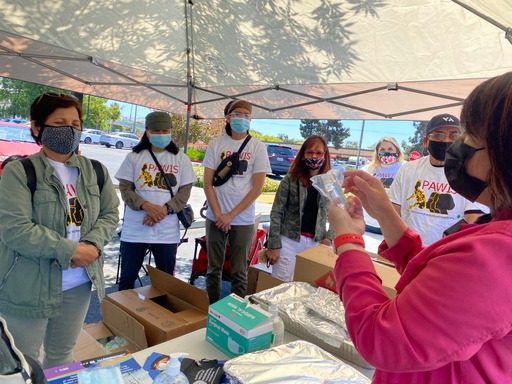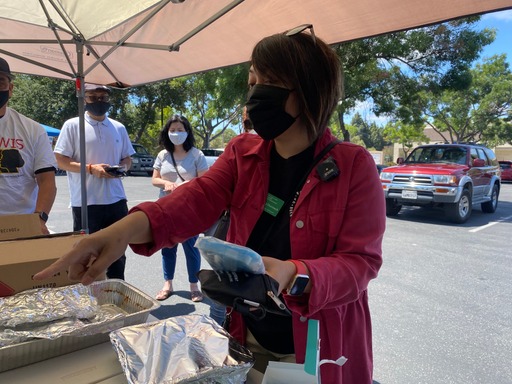Centering Stories of Filipino Caregivers: Kuwentuhan as Method and Praxis for Migrants Collective Power
Valerie Francisco-Menchavez, Associate Professor, San Francisco State University Pilipino Association Workers and Immigrants (PAWIS), Silicon Valley
Abstract
In our collaboration, Pilipino Association Workers and Immigrants (PAWIS), an organization of Filipino migrant workers, and Dr. Valerie Francisco-Menchavez generated discussion regarding how caregivers were faring in the pandemic through a method that Dr. Francisco developed called kuwentuhan, a type of Filipino talk-story. The power of culturally-responsive methodologies for political organizing and research processes reminds us that systematic methods exist outside the purview of officially condoned “knowledge-making” institutions. This case study shows the power of centering the cultural practices and knowledge of migrants as the momentum for political organizing and research. These virtual Zoom kuwentuhan spaces and communication practices asked caregivers to rely on their cultural knowledge to take part in the new virtual platforms of the pandemic. While the Zoom events offered caregivers practical advice in navigating a changing world, kuwentuhan also allowed caregivers to recognize one another in their vulnerability and humanity through the cultural practice of talk-story.
Project Narratives
About The Invisible Frontliners
There has been much attention on healthcare front liners in the fight against COVID-19 — mainly doctors and nurses working in hospital settings in the United States. Other types of frontline workers who provide health and other kinds of care have primarily been unacknowledged in their roles as essential workers. As nursing homes and residential care facilities emerged as hot spots for COVID-19, many caregivers to the elderly were at high risk of contracting and spreading the virus. While their workplaces surged as sites of transmission, caregivers wondered if the same protections that hospital workers clamored for would be available to them. Given eldercare’s lack of funding and its general invisibility in the healthcare landscape, basic workplace protections like Personal Protective Equipment (PPE) were also out of reach for the caregivers who provided essential care for the population most vulnerable to COVID-19: those over 65 with pre-existing conditions.
Broadly, Filipino migrants are overrepresented among healthcare workers in a range of healthcare occupations in the US. While nurses make up only 4% of the nursing population in the US, nearly a third of the nurses who have perished from COVID-19 are Filipino (McFarling 2020). The pandemic’s demand for care workers has disproportionately caused deaths in the Filipino American community.
Yet, Filipinos serve on multiple frontlines. Filipino care workers in the San Francisco/Bay Area are at the frontlines of assisted living facilities, residential care facilities for the elderly (RCFEs), and as personal attendants to chronically ill and differently-abled people. They are the caregivers that staff the many workplaces that provide care to the most vulnerable.
The COVID-19 pandemic has exacerbated existing crises in caregiving that many Filipino caregivers have lived with for decades. The racial inequities under COVID-19 — amplified by profit-driven, neoliberal approaches to elder care — put care workers at more risk. A compliance study conducted by the Department of Labor (DOL) in the Bay Area found gross wage and hour violations in residential care facilities for the elderly (RCFEs) (California Advocates, 2013). Conditions reported in the study were detrimental to the health and safety of the workers and the quality of care provided to the residents. In a recent study, I found that over 30% of Filipino caregivers do not have regular access to disposable Personal Protective Equipment (PPE) in their workplaces. This can lead to workers being put at higher risk of contracting COVID-19 and spreading it to their patients, families, and communities. Yet struggles to secure personal protective equipment, safe work conditions, and stable work persists in the shadows.
As a sociologist and faculty member at San Francisco State University, I have engaged in collaborative community-based research with Pilipino American Immigrant and Workers (PAWIS), an organization of Filipino migrant workers in the South Bay Area. Our work aims to tell the stories of Filipino care workers, both their struggles and resilience, to shed light on this essential work and essential needs for this sector of frontline workers. We pay special attention to the power of “kuwentuhan,” a type of Filipino talk story that is an inspiring form of knowledge production and productive research and community organizing methodology.

Obstacles and Strategies
The work of caregiving is already one that is isolated. Caregivers work in a range of settings — such as assisted living facilities — that can have many beds and patients on a single wing or floor. Other caregivers work in small teams of two or three in non-hospital settings: for example, in homes that are turned into facilities for eldercare. Still, others conduct one-on-one visits to private homes. Often, caregivers work on their own in private settings.
Filipino caregivers who experience loneliness and isolation at their workplaces depend on community gathering spaces to find respite. Church and fellowship, Filipino restaurants, shopping centers, community centers, and Filipino ethnic events all serve as social gathering spaces, providing relief from the isolation of caregiving work. Caregivers use these spaces to exchange information about jobs, housing, and current events. They celebrate their milestones, and birthdays and remit money to their families in the Philippines. This social support network was robust and served both pragmatic and leisurely purposes.
During the COVID-19 pandemic, however, the characteristic isolation of caregivers was exacerbated. Before the pandemic, some caregivers might have integrated meetups at parks or nearby malls into their weekly routines. With the lockdowns, caregivers and their patients could not leave their premises. Public places became dangerous for their clients. While caregivers’ work routines stayed the same, their communal spaces and events disappeared. This lack of contact among community members foreclosed the opportunity to exchange information about the pandemic. The responsibility of tracking down basic information about the virus and how to protect oneself was hoisted onto the shoulders of individual caregivers. What caregivers could expect from their employers regarding safety and health protection was limited by what employers communicated to their employees. The opportunity to learn what other caregivers were demanding from their employers — and perhaps what employers were willing to provide — was shut down because caregivers’ lack of access to communal spaces.
As the world turned to videoconference and remote work and school, caregivers were at a loss. Caregivers were not considered a workforce that could opt out of coming into their workplaces. They were essential workers as they provided the critical care needed by their patients. When asked if the lockdown affected their work hours, the caregivers I spoke to replied that their schedules did not change and were still required to come into their facilities. The hours they worked in the care homes were extended because caregivers felt the responsibility of protecting their patients from COVID-19. Even so, caregivers did not have quick access to computers, training, and remote information communication technologies (ICT) and so were left out of the digital transition. Additionally, Filipino caregivers who are generally between 45 to 55 years old may not have had the technological literacy to adapt to pandemic ICTs.
The innovation of PAWIS to address these issues became a powerful pivot in our research and community organizing. Early in the pandemic, one way to keep in touch with caregivers in the PAWIS organization was through group text apps such as Groupme or Whatsapp. But soon enough, PAWIS worker leaders became convinced that the pandemic would likely last for a very long time. The organization then explored how to convene its members through Zoom. PAWIS leaders activated a Filipino cultural practice called “kapihan” — or a coffee break, loosely translated into English — as monthly Zoom events for caregivers to attend.
Although the virtual Zoom space isn’t the same as in-person socializing, caregivers (and many Filipino immigrants before them) were already familiar with translating their day-to-day lives into virtual formats like Facebook, FaceTime, and Instagram, given their relationships with their families in the Philippines. The “kapihan” events not only sought to create social spaces for caregivers to connect but also offered practical advice from labor lawyers in regards to navigating fast-changing federal and state-level benefits for unemployment or paycheck assistance. Both the opportunity to connect with other caregivers and to receive legal advice were compelling reasons to come together. Even though Zoom required Filipino caregivers to learn a new app and troubleshoot connectivity in their workplaces, PAWIS worker leaders committed to training their members by phone.
In our collaboration, PAWIS and I generated great discussion regarding how caregivers were faring in the pandemic through “kapihan.” In a method that I have developed, called “kuwentuhan,” a type of Filipino talk-story, virtual story sessions were conducted via Zoom over the course of the pandemic. In early kuwentuhan sessions, I partnered with worker leaders — teaching these leaders about how one could spark a conversation. For example, during a kapihan, I would offer a theme or a topic to the group and allow the conversation to be taken up and led by the caregivers present. Although starting a kuwentuhan would often be slow, caregivers would soon take up the discussion quickly thereafter, as it was in their nature to build on one another’s ideas.
Through kuwentuhan, it was clear that caregivers appreciated the opportunity to hear how others were confronting unprecedented times of global pandemic. In these exchanges, many caregivers were able to communicate their anxieties and concerns regarding contracting the virus, the health of their patients, and their livelihoods and health histories. These sessions were also useful in sharing standards of care and workplace protections in care homes and, more importantly, the lack thereof. The type of conversation we fostered on Zoom through kuwentuhan gave workers a chance to relax in the virtual spaces they were interacting on. To this day, kapihans continue with kuwentuhan at its core.

Lessons for Change: Transformative Methodologies
The power of culturally-responsive methodologies for political organizing and research processes reminds us that systematic methods can and are already happening outside of the purview of officially recognized knowledge-making institutions. Academia and hospitals are institutions that Filipino immigrants, especially caregivers, regard as institutions of knowledge. However, in the throes of a pandemic, these very institutions became cumbersome in acknowledging the needs of frontline workers in the fight against COVID-19. Additionally, traditional research methods that might require face-to-face data collection were impossible. The institutions of knowledge that caregivers might have recognized before the pandemic became institutions that could not adjust to their day-to-day conditions.
With PAWIS as a case study, we have come to understand that methodologies must be responsive to the material conditions of participants’ political struggles. This is an important lesson for engaged scholars, activists, and artists. This project demonstrates that beginning with an understanding of the conditions of community members’ lives can lead to methodologies that speak to the specific needs of that community.
This case study shows the power of centering cultural practices and knowledges of migrants as the momentum behind political organizing and research. Both kapihan and kuwentuhan were practices that invited Filipino caregivers and migrants to enter research and organizing spaces as they were. These virtual spaces and communication practices asked caregivers to rely on their cultural knowledge as they engaged with new virtual platforms. While Zoom events offered caregivers the advice they needed in navigating the changing world, kapihan and kuwentuhan also allowed caregivers to recognize one another in their vulnerability and humanity through the cultural practice of talk-story.
Lastly, as a scholar-activist, community member, daughter, and granddaughter of Filipino migrants who has worked in eldercare, this project was an opportunity for me to bring my fragmented selves together. Before the Stories of Change case study project, I would serve this community as a scholar through a peer-reviewed article, as an activist at a rally, as an advocate for caregivers’ rights at a lobbying event at the state capitol, or simply as a family member remembering the stories of my relatives who are caregivers. Until Imagining America’s Stories of Change, I have never had the ability to bring all of these selves together, juxtapose them and think through the methodologies I’ve learned from my family members and community members. Often, I feel a pull between my intersecting and overlapping identities through my research. Still, this digital storytelling project invited me to bring the textures of those knowledges together as a creative, an activist and a scholar. The digital storytelling project I produced is both a process of reflexivity and creativity. I offer this narrative and project as an invitation to recognize and honor the various and complementary subjectivities we embody as we move about in the world.


